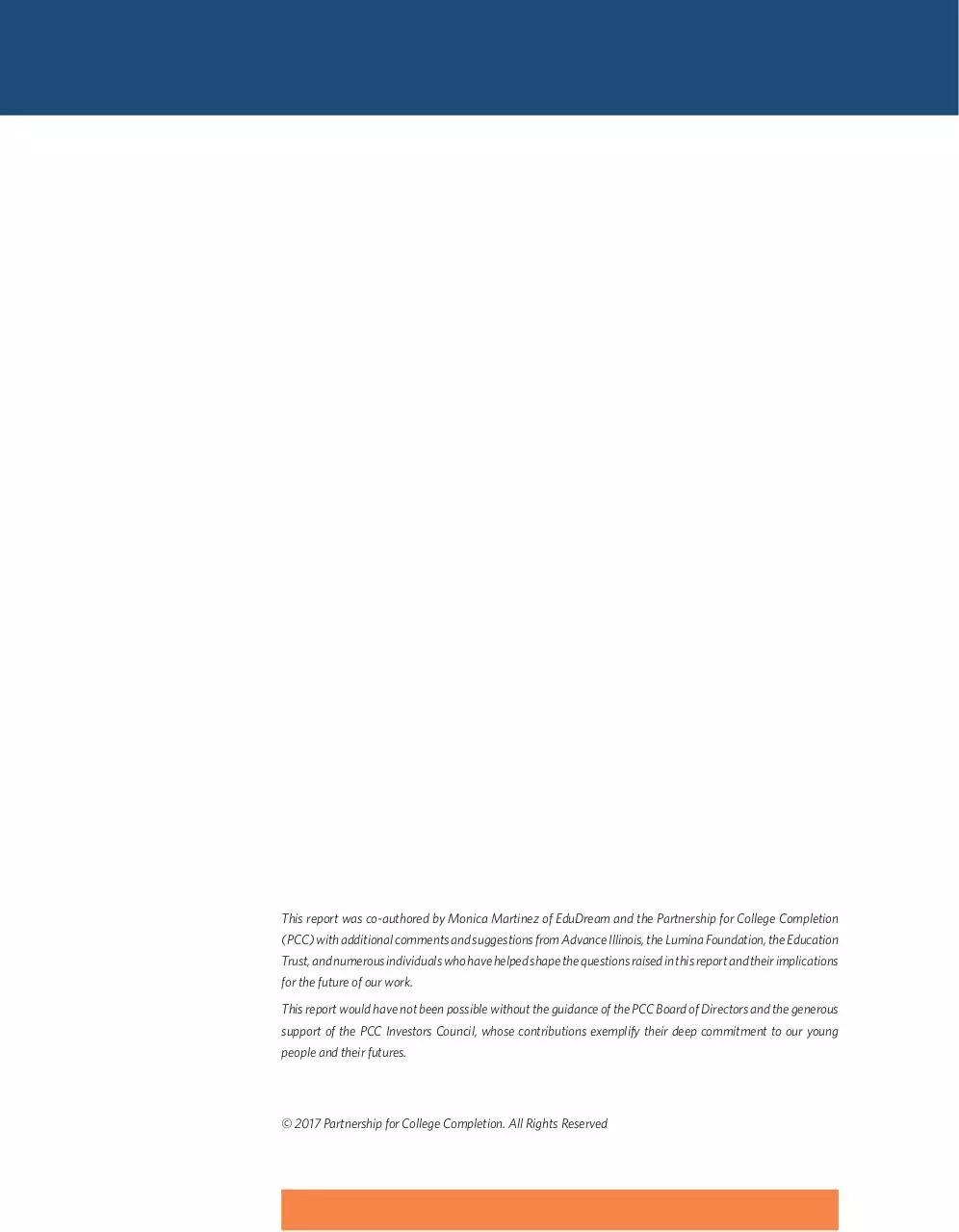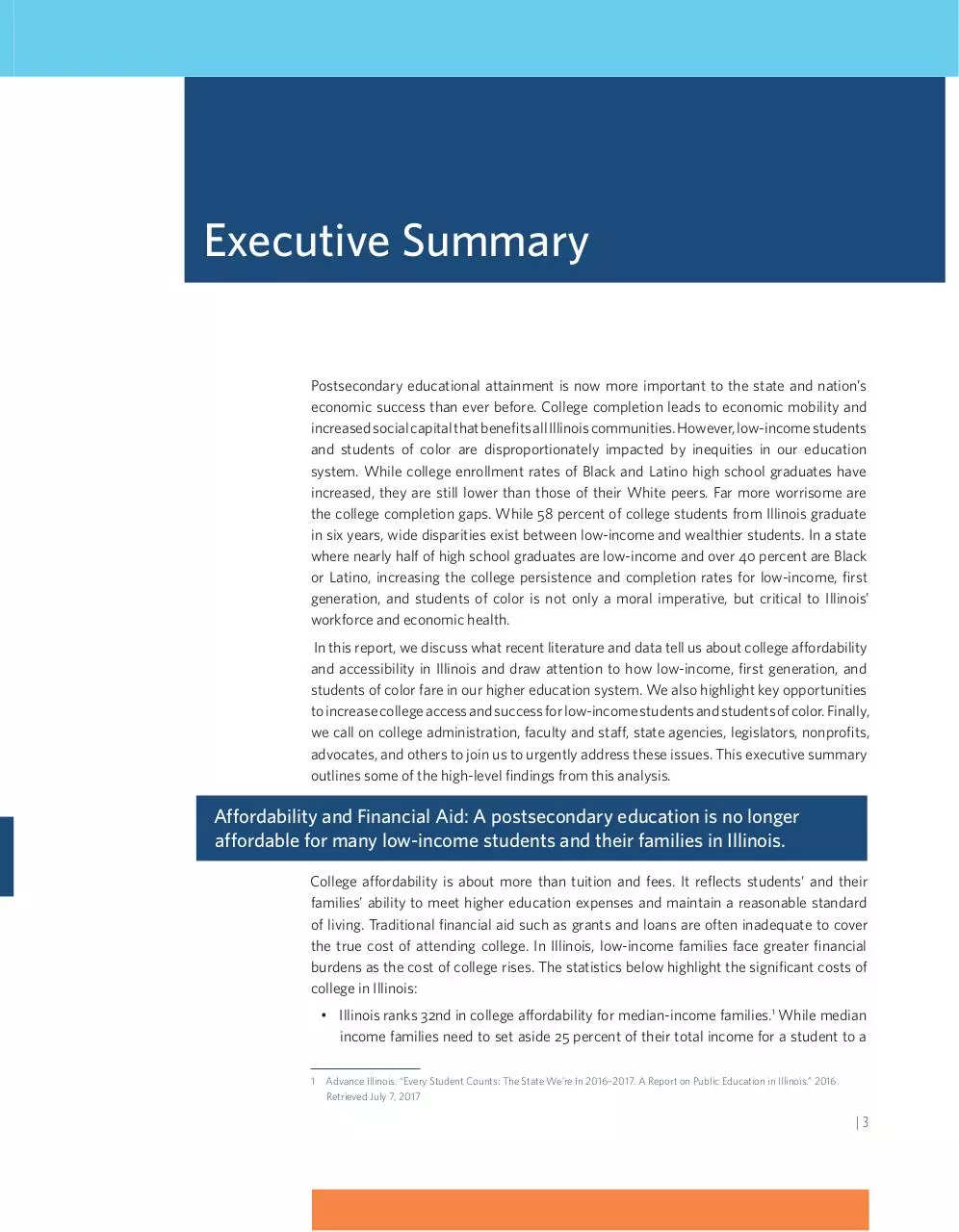Unequal Opportunity in IL (PDF)
File information
This PDF 1.4 document has been generated by Adobe InDesign CC (Macintosh) / Adobe PDF Library 10.0.1, and has been sent on pdf-archive.com on 13/12/2017 at 22:24, from IP address 204.148.x.x.
The current document download page has been viewed 733 times.
File size: 3.71 MB (24 pages).
Privacy: public file





File preview
Unequal Opportunity
in Illinois:
A Look at Who Graduates College and
Why It Matters — A Meta-Analysis
September 2017
PARTNERSHIP FOR
COLLEGE COMPLETION
Accelerating action to close the graduation gap
This report was co-authored by Monica Martinez of EduDream and the Partnership for College Completion
(PCC) with additional comments and suggestions from Advance Illinois, the Lumina Foundation, the Education
Trust, and numerous individuals who have helped shape the questions raised in this report and their implications
for the future of our work.
This report would have not been possible without the guidance of the PCC Board of Directors and the generous
support of the PCC Investors Council, whose contributions exemplify their deep commitment to our young
people and their futures.
© 2017 Partnership for College Completion. All Rights Reserved
September 2017
Letter from the Board Chair & Executive Director
September 2017
The Partnership for College Completion is a new organization with a charge to advance system
level change to improve college graduation rates for low-income and first generation students
in the Chicago metro area. Since being launched by the foundation community in and around
Chicago, PCC has listened to leaders in higher education, K–12, philanthropy, business,
local and state government, nationally focused higher education organizations, and others
to understand the unique challenges facing low-income students in Illinois, as well as the
innovative approaches to meeting those challenges.
Illinois is the 6th most populous state in the country with the 5th largest economy. Maintaining
or even improving these data requires that Illinois build a dynamic and diverse workforce
and civic culture capable of producing a state in which opportunities are equal and pathways
to progress numerous. Recently, with the passage of Senate Bill 1, Illinois finally recognized
that the K–12 schools serving low-income students have greater and more complex needs.
This basic recognition has not, however, extended to higher education. The bitter irony is
that at a time in Illinois when the population of low-income students is increasing, funding
to the state’s higher education system has continued to diminish.
In this report, we synthesize previously published reports and data from state agencies like
the Illinois Student Assistance Commission, the Illinois Board of Higher Education as well as
national researchers such as the Education Trust, Complete College America, and others to
shed light on the complex challenges facing low-income and first generation students in Illinois.
These data and reports paint a sobering picture of the current trajectory of low-income
students and students of color as they attempt to earn the degrees and credentials necessary
for full participation in the state’s economic and civic life.
The Partnership will use this and subsequent publications to both raise public awareness on
issues related to improving completion rates for low-income students, as well as inform our
work alongside institutions of higher education and elected officials.
While the challenges that students face in graduating on time and with as little debt as possible
are growing, so is the commitment by leaders in higher education, philanthropy, and local
government to collaborate in support of our students. Innovative approaches and initiatives
are being implemented across the nation and within the state of Illinois to urgently address
the challenges that our students are facing. We look forward to working in partnership
with these leaders and others in the state to reverse the current direction of the state and
instead chart a path for Illinois to become a leader equity in attainment.
Greg Darnieder
Kyle Westbrook
Chair, Partnership for College Completion
Executive Director, Partnership for College Completion
|1
Board of Directors
Greg Darnieder (Board Chair) - Former Senior Advisor to the Secretary on the College
Access Initiative, U.S. Department of Education
Dave Agazzi - Former Vice President of Administrative Affairs, College of Lake County
Arne Duncan - Managing Director, Emerson Collective
Sherry Eagle - Executive Director Emeritus, Institute for Collaboration, Aurora University
Judy Erwin - Managing Director, Kivvit
Ricardo Estrada - President and CEO, Metropolitan Family Services
Brian Fabes - CEO, Civic Consulting Alliance
Adam Levine - President, Circle of Service Foundation
Laz Lopez - Associate Superintendent for Teaching and Learning, High School District 214
Joseph McCoy - Partner, Riley Safer Holmes & Cancila
Nivine Megahed - President, National Louis University
Tim Schwertfeger - Former Chairman and CEO, Nuveen Investments
Liz Thompson - President, The Cleveland Avenue Foundation for Education
Staff
Kyle Westbrook - Founding Executive Director
Lisa Castillo Richmond - Director of Strategy
Emily Goldman - Program and Policy Analyst
Jonathan Lopez - Special Projects Coordinator
Greg Wilson - Program and Policy Analyst
September 2017
Executive Summary
Postsecondary educational attainment is now more important to the state and nation’s
economic success than ever before. College completion leads to economic mobility and
increased social capital that benefits all Illinois communities. However, low-income students
and students of color are disproportionately impacted by inequities in our education
system. While college enrollment rates of Black and Latino high school graduates have
increased, they are still lower than those of their White peers. Far more worrisome are
the college completion gaps. While 58 percent of college students from Illinois graduate
in six years, wide disparities exist between low-income and wealthier students. In a state
where nearly half of high school graduates are low-income and over 40 percent are Black
or Latino, increasing the college persistence and completion rates for low-income, first
generation, and students of color is not only a moral imperative, but critical to Illinois’
workforce and economic health.
In this report, we discuss what recent literature and data tell us about college affordability
and accessibility in Illinois and draw attention to how low-income, first generation, and
students of color fare in our higher education system. We also highlight key opportunities
to increase college access and success for low-income students and students of color. Finally,
we call on college administration, faculty and staff, state agencies, legislators, nonprofits,
advocates, and others to join us to urgently address these issues. This executive summary
outlines some of the high-level findings from this analysis.
Affordability and Financial Aid: A postsecondary education is no longer
affordable for many low-income students and their families in Illinois.
College affordability is about more than tuition and fees. It reflects students’ and their
families’ ability to meet higher education expenses and maintain a reasonable standard
of living. Traditional financial aid such as grants and loans are often inadequate to cover
the true cost of attending college. In Illinois, low-income families face greater financial
burdens as the cost of college rises. The statistics below highlight the significant costs of
college in Illinois:
• Illinois ranks 32nd in college affordability for median-income families.1 While median
income families need to set aside 25 percent of their total income for a student to a
1 Advance Illinois. “Every Student Counts: The State We’re In 2016–2017. A Report on Public Education in Illinois.” 2016.
Retrieved July 7, 2017
|3
Unequal Opportunity in Illinois: A Look at Who Graduates College and Why It Matters
attend public four-year institution, low-income families require 63 percent of family
income.2
• In fiscal year 2016, Illinois’ average public university in-state tuition and fees were the
fifth highest in the nation.3
• Among Illinois students who graduate from public and private four-year institutions,
two-thirds have debt with an average of nearly $30,000.4
Furthermore, the Illinois state budget challenges have led to reductions in funding for the
state’s community colleges and public universities. These higher education cuts disproportionately impact low-income students and students of color who are more likely to receive
need-based aid and attend public institutions. Rising tuition and decreased purchasing
power of financial aid has likely contributed to a mass exodus of college students from
Illinois. Given the state’s demographics, addressing college affordability to retain collegebound students will be critical to Illinois’ short and long-term viability.
• Illinois is one of only four states that cut funding of higher education over the last two
fiscal years, a year to year difference of 68 percent.5
• The cost of attending college in Illinois has far outpaced the amount of Monetary
Award Program (MAP) grants available, which help make college possible, especially
for students of color. Over half of MAP recipients are first generation students and more
than half of Black and Latino undergraduates at public universities receive a MAP grant.6
• In fiscal year 2016, over 160,000 students (50 percent of those eligible) could not
claim awards due to insufficient funding.7
• In 2014, Illinois was 49th in the nation in net migration of college freshmen to other
states’ public colleges, a 70 percent increase over a decade.8
Access: College access has improved, but gaps persist for low-income
students and students of color in Illinois.
As a state, Illinois has made great gains in on-time high school graduation rates leading
to increased college access. But low-income students and students of color are still not
enrolling in college at the same rates as their wealthier peers. Moreover, they attend less
selective institutions that have lower completion rates. As a result, students of color are
less likely to earn college degrees.
• Undergraduate enrollment of Illinois students of color has steadily increased in the
2 Midwest Higher Education Compact. Higher Education in Focus: Selected Performance Indicators, 2014–2015.
3 The College Board, “Trends in College Pricing 2016,” 2016, 20.
4 Cochrane, D, & Chang, D. “Student Debt and the Class of 2015: 11th Annual Report.” Project on Student Debt (2016).
5 Center for Tax Budget Accountability. “Illinois’ Significant Disinvestment in Higher Education.” (2017).
6 Illinois Student Assistance Commission. “Monetary Award Program (MAP) Evaluation,” 2015.
7 Illinois Student Assistance Commission. “2016 Data Book,” 2016.
8 Illinois Board of Higher Education. (January 2017). Outmigration Context: Residence and Migration Patterns of Freshmen
Students into and from Illinois (IBHE DataPoints 2017-1). Springfield, IL.
4|
September 2017
last ten years, from 37 percent in 2006 to 46 percent of total enrollment in 2016.9
• Black and Latino students in the state tend to be more highly concentrated in community
colleges and for-profit institutions than their peers; 46 percent of Black and 55 percent
of Latino student were enrolled in public two-year institutions compared to 23 percent
in public four-year institutions.10
• From 2011 to 2015, Illinois saw a drastic decrease in African-American undergraduate
enrollment in public institutions (25% total decrease).11
Completion and Success: College completion rates in Illinois remain unequal
along racial and ethnic lines
While national college completion rates for Latinos and African-Americans have been
climbing upward, gaps persist between these groups and their White peers. Stark disparities
exist across racial lines, particularly for community college students.
• In Illinois, the average college completion rate in 2015 was 61.7 percent at a four-year
public institution and 25.5 percent at a two-year public institution.12
• In contrast, only 33.7 percent of Black students who start at four-year institutions
earn bachelor’s degrees within six years—a rate 32.7 percentage points below that of
their White peers.13
• The completion gap between low-income and wealthier students is alarming: only 37
percent of low-income students graduate in six years while 75 percent of wealthier
students do.14
Implications for Policy and Practice
Recent trends in college affordability, access and attainment have clear implications
for state policy leaders, practitioners, and community leaders committed to improving
post-secondary success. There is a real opportunity to champion targeted strategies and
innovative models, replicate successful approaches, and thereby increase college access
and completion for Illinois students, particularly low-income students and students of color.
• Ensuring an affordable and efficient path for those who aspire to college degrees
needs to be a goal for state higher education policy. Increasing state investments
in need-based aid and raising awareness of grants and other means of financial
assistance will be critical in ensuring access and affordability for low-income students.
9 Illinois Board of Higher Education, 2016 Illinois Board of Higher Education, Underrepresented Groups in Illinois Higher
Education, 2016 Annual Report, 2017.
10 Ibid
11 Ibid
12 National Center for Education Statistics. Digest of Education Statistics 2015.
13 Ibid
14 Advance Illinois, 2016.
|5
Unequal Opportunity in Illinois: A Look at Who Graduates College and Why It Matters
• Greater research and analysis is needed on the factors contributing to the steep
decline in African-American student enrollment in state public institutions.
• Championing and scaling evidence-based models that already exist across the nation
and state and that have proven successful in increasing graduation rates and reducing
time to degree.
• Reorient campus cultures, systems, and practices to prioritize student success in
order to significantly boost graduation rates among underrepresented students.
6|
September 2017
Introduction and Overview
Not since the 1960s has the United States and the state of Illinois faced such a defining
moment as currently exists today. In an era of increased global competition, growing
income and wealth inequality, and limited and decreasing public investments, pathways
into the middle class for low-income Americans are shrinking. Nowhere is this dilemma
more visible than in higher education in Illinois. While students in Illinois are graduating
from high school in greater numbers and better prepared than ever, college graduation
rates for low-income students remain unacceptably low. In 2015, low-income students in
Illinois graduated from college at a rate of 37 percent compared to 75 percent for their higher
income peers. Today, as students in Illinois are becoming increasingly low-income and
increasingly minority, their chances of actually graduating from college are only marginally
better than they were 30 years ago. If there has ever been a need for innovation in higher
education, it is now. If there has ever been a need for elevating student success as
the single highest priority for all of institutions of higher education, it is now. In order
to truly realize the promise of equal opportunity that was fought for in the civil rights
era, Illinois must commit to its students for the sake of equity and its own long term
economic health.
Postsecondary educational attainment is now more important to the state and nation’s
economic success than ever before. As more jobs require higher levels of education, workers
with only a high school diploma are finding it increasingly difficult to enter the middle class.
A study by Georgetown University’s Center on Education and the Workforce suggests
that “by 2020, 65 percent of all jobs in the United States (U.S.) economy will require postsecondary education and training beyond high school.” Despite recent reports questioning
the value of a college degree,15 the benefits of higher education are clear. Today, those with
higher levels of education earn more, are more likely to be employed, are more civically
engaged, and more likely to move up the socioeconomic ladder.16 Currently, only about 45
percent of adults in the U.S. have earned a degree or credential of economic value.17 In
Illinois, 50 percent of residents between the ages of 25–64 hold a postsecondary degree or
high-quality credential beyond high school.18 In a state that has seen a dramatic increase
in the number of low-income students in the past ten years, expanding access to postsecondary education and closing stagnant completion gaps, particularly for low-income
students and students of color, is a moral imperative. This reality has mobilized Illinois
15 Goldman Sachs. What if I Told You… The Goldman Sachs Group, Inc., 2015.
16 Ma, J., Pender, M., Welch, M. Education Pays 2016: The Benefits of Higher Education for Individuals and Society.
The College Board, December 2016
17 Lumina Foundation. A Stronger Nation. Full Report 2017, May 2017.
18 Ibid., 92.
|7
Download Unequal Opportunity in IL
Unequal_Opportunity_in_IL.pdf (PDF, 3.71 MB)
Download PDF
Share this file on social networks
Link to this page
Permanent link
Use the permanent link to the download page to share your document on Facebook, Twitter, LinkedIn, or directly with a contact by e-Mail, Messenger, Whatsapp, Line..
Short link
Use the short link to share your document on Twitter or by text message (SMS)
HTML Code
Copy the following HTML code to share your document on a Website or Blog
QR Code to this page

This file has been shared publicly by a user of PDF Archive.
Document ID: 0000708310.